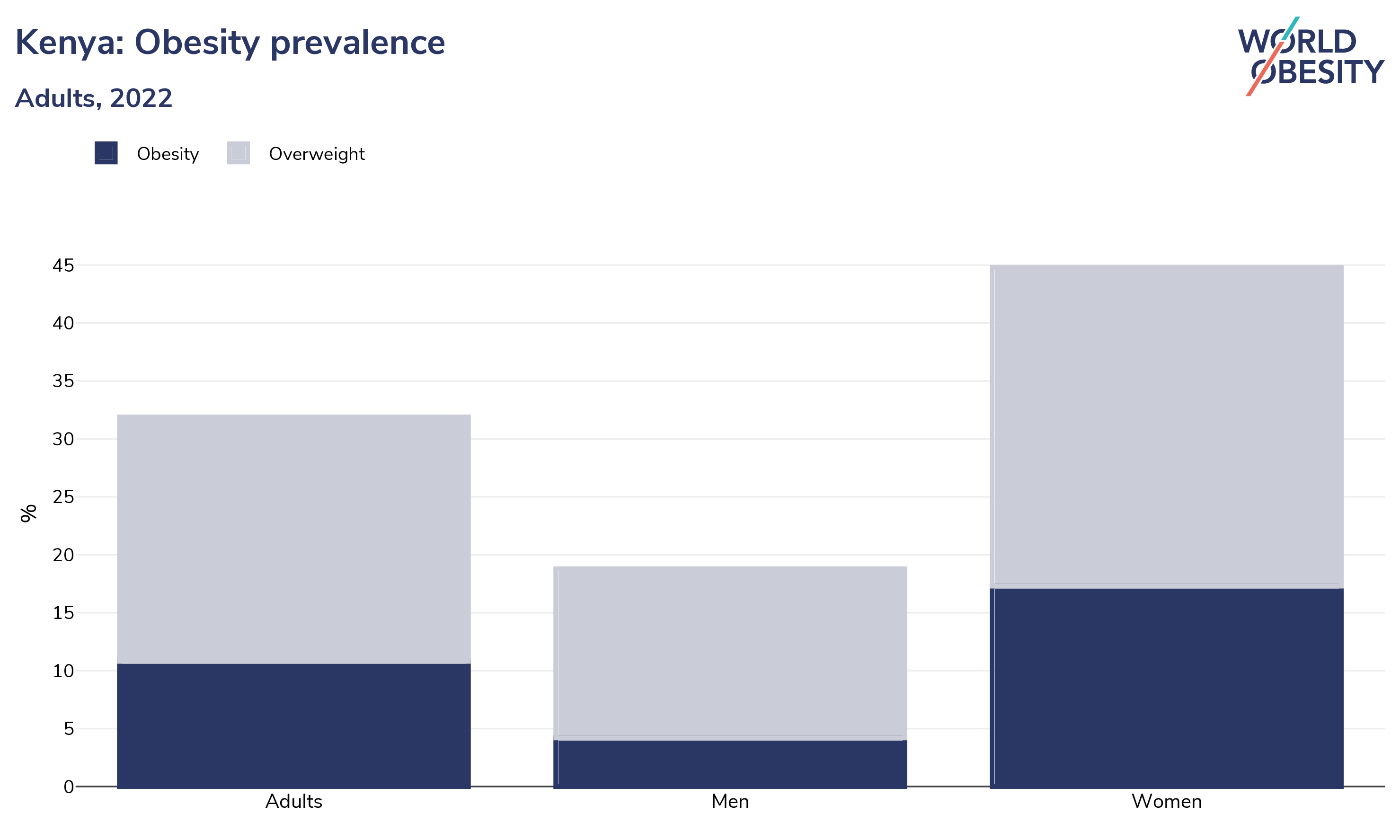By Jackson Okata
Nairobi, Kenya: In 2022, Joseph Korir, 38, was forced to take a sabbatical from his accountancy job in Nairobi on medical grounds. The father of two, says his weight could not allow him to sit for long hours as his job demanded. For 10 years, Korir would spend 10 hours every working day at his office desk balancing spreadsheets and budgets with precision. Unhealthy diets and lack of exercise saw him become obese causing him health complications.
“I had no time for exercising and my diet was mainly fast and processed foods and sugary beverages. Before I knew it, my weight was hitting the roof’’ said Korir.
He added, “At 165 kgs, walking for long distances became hectic and it took a toll on my health. Sitting for long hours became unbearable and the strain on my back and joints made working impossible”.
Korir says he had to make the hard decision of taking a sabbatical to regain his health after being diagnosed with prediabetes, a condition which saw his blood sugar rise above maximum.
“Doctors warned that I was at a higher risk of suffering from type 2 diabetes and we embarked on a weight loss and management journey with the help of a nutritionist and a fitness trainer. Financial adjustments that came with it affected my family’s lifestyle’’ he said.
The father of two says the journey of shading half of his initial body weight has not been easy but attributes his success to a healthy diet and lifestyle change.
Obesity and NCDs
The World Health Organization (WHO), says obesity is a risk factor for several non-communicable diseases including diabetes, cardiovascular disease, and cancer. WHO defines obesity as a chronic complex disease defined by excessive fat deposits that can impair health.
According to the World Obesity Atlas, an estimated 1.4 million Kenyans aged between five to 19 years will be obese by 2030. The WHO considers a person with a body mass index (BMI) over 25 to be overweight, while a BMI over 30 is obese.
Kenya’s government recognized obesity as a major risk factor for non-communicable diseases (NCDs) such as diabetes and cancer, which are responsible for 39% of deaths in Kenya as of 2022 up from 27% in 2014.
Women most affected
Milka Adhiambo, a single mother of two, owned a fast food joint in Pioneer Estate in Eldoret town. A young employer with a staff of ten, Milka always sat at the counter as the main cashier of her business. Milka says that her sweet tooth got her addicted to the fast foods and sweetened sugary drinks she was selling and before she knew it, she was battling obesity.
“Fries and cold coke became my main and daily meal. It was an addiction I couldn’t just resist and within two years my weight had almost tripled. Breathing, walking, and doing simple chores became a struggle’’ said Milka.

In 2020, Milka joined a weight management and loss support group in Eldoret town, a group that brings together women battling overweight issues and she began the journey to regaining her health. The group activities, Milka says, helped her shed the addiction to fast foods but the addiction to cold coke instead increased.
“It has been a struggle letting Coke go but with time I am sure I will be there’’ she says with a smile
The Kenya Demographic Health Survey (KDHS) 2022 report showed that the percentage of women falling into the obese category has increased from 38 percent in 2014 to 45 percent in 2022.
A study dubbed Obesity and Women’s Health: An evidence-based review, published in the Journal of the American Board of Family Medicine, found that being overweight or obese increases the relative risk of diabetes and coronary heart disease in women. Research from the Centres of Disease Control links overweight and obesity with body changes that may lead to cancer.
“Women who are obese have a higher risk of low back pain and knee osteoarthritis. Maternal obesity is associated with higher rates of high-risk obstetric conditions such as diabetes and hypertension,” the study reads in part.
Increased Cases of Adolescent Diabetes
For Stanley Wekesa, college life turned him into an addict of sweetened sugar beverages and alcohol. The 22-year-old student says his shared hostel turned into a minibar.
“Even in class, my bag would contain a few bottles of energy drinks to help me quench my thirst during lecturers’’ says Wekesa
In January 2024, Wekesa who was then battling obesity was diagnosed with type 2 diabetes, a condition he blames on the over-consumption of sweetened sugar beverages and unhealthy diets. Hospital visits have since become part of his life.
“Currently, I am on a strict diet to complement my medication even as I work on cutting my weight’’ narrated the Maseno University student.
Dr Davis Ombui, a Nairobi-based consultant diabetologist says there is a rising number of young people being diagnosed with diabetes. He points to unhealthy lifestyles as the cause of most cases of diabetes among young people.
“We have more young people being diagnosed with diabetes and in most cases, It’s all because of obesity; all because of the lifestyle. Fast food is now a class and the main thing in our cities and the young people are victims” he says.
He adds “Healthy eating habits including limiting consumption of sugary drinks and unhealthy foods and frequent physical activity are sure ways of reducing the burden of obesity among young people”.
Policy Inefficiencies
Despite Kenya’s proactive measures to combat non-communicable diseases (NCDs) such as through the National Strategy for Control and Prevention of Noncommunicable Diseases and the Kenya Health Policy, however, Kenya lacks a specific tax on sugar-sweetened beverages, and there is a conflict of interest between the ministries of Health and Trade. This conflict hinders the development of a policy on sugar-sweetened beverages. This investigative story aims to uncover the complexities and implications of non-compliance and the increasing burden of overweight and obesity cases in the country.
Goal number two of the Kenya Health Policy 2014-2030 is to reduce the growing burden of non-communicable diseases. In 2023, the Ministry of Health published a strategic plan that recognized obesity as a major risk factor in the rising cases of non-communicable diseases.
It is estimated that over 9.5 million Kenyans will reach obesity by 2035 if the country’s preparedness to tackle the condition does not improve. Kenya seeks to reduce its obesity prevalence to 26% in 2025 with NCD deaths expected to increase by 55%. According to the World Obesity Atlas 2023 Report, Kenya’s global obesity preparedness ranks at 143 out of 183 globally, with the country projected to reach 18 percent obesity in the next 12 years. Kenya is expected to attain an annual increase of 4.6 percent in adult obesity and 8.2 percent in childhood obesity by 2035, both of which are considered alarmingly high.
Experts partly blame the rise in cases of obesity on digital food apps and advertising which have changed food consumption and purchasing. They say the food delivery apps and the increased misinformation about healthy family meals are some of the main threats facing the fight against obesity.
Eldoret-based consultant nutritionist Nelli Wangari agrees that the rising prevalence of obesity in Kenya is deeply intertwined with lack of exercise, consumption of unhealthy diets, and sweetened sugar beverages. She adds that “these products, often high in empty calories, contribute significantly to excessive weight gain and various associated health issues like diabetes”.
“What we need are comprehensive public health measures to promote public education on healthy eating habits, regulate the availability and marketing of unhealthy foods, and encourage individuals to make healthier choices for long-term well-being’’ she says.
Dr. Gilbert Were, a researcher from Kenyatta University focusing on obesity prevention and non-communicable diseases (NCDs) in Kenya recommends stringent policy enforcement to regulate the availability, marketing, and consumption of SSBs, including measures such as taxation, labeling requirements, and restrictions on advertising which he says will protect public health and mitigate the burden of NCDs in the population.
“SSBs are major contributors to the obesity epidemic and the rise of NCDs such as diabetes and cardiovascular diseases in Kenya. Unless we impose strict and prohibitive rules and taxes on these manufacturers, the situation will only get worse ” says Dr. Were.
Dancun Mathenge, a member of the Parliamentary Departmental Committee on Health of the National Assembly blames the inadequate coordination between government institutions for the inefficiencies in the national food safety control system.
“We are in the digital age and our old laws must be restructured to resonate with the current times. We must have regulations to control the spread of misleading information about health and diets that is spread through social platforms. We must force anybody producing and selling a product that might harm the buyer to be candid enough and tell the consumer the effects of consuming such food items’’ he said.
According to the African Population & Health Research Center (APHRC), rapid urbanization in Kenya has seen a rise in levels of obesity and other diet-related non-communicable diseases (NCDs) due to overconsumption of unhealthy diets that are energy-dense and nutrient-poor due to unhealthy food environments
Kenya’s NCDs War
The Kenya Health Policy 2014-2030 has the halting and reversing of the rising burden of non-communicable conditions as one of its key objectives however the country has seen an increase in obesity fueled by the consumption of processed foods with high sugar and fat content.
The World Health Organisation warns that the number of deaths attributable to non-communicable diseases (NCDs) will rise by 55 percent by the end of the decade. In Kenya, data from the Ministry of Health shows that NCDs are responsible for more than 50 percent of in-patient hospital admissions and 39 percent of all deaths annually in Kenya.
In 2022, 1 in 8 people in the world were living with obesity. Worldwide adult obesity has more than doubled since 1990, and adolescent obesity has quadrupled. In 2022, 2.5 billion adults (18 years and older) were overweight. Of these, 890 million were living with obesity 43% of adults aged 18 years and over were overweight and 16% were living with obesity. Over 390 million children and adolescents aged 5–19 years were overweight in 2022, including 160 million who were living with obesity.
Dr. Were however notes that the fight against NCDs is more of a personal responsibility than a government one.
“As an individual, you have the power to make choices on what ends up on your plate. People must make the decision to stop taking poison in the name of the food and before the government plays its part we must as Kenyans act responsibly’’
The production of this story was enabled by gracious support from the Non-Communicable Diseases Alliance (NCDA) Kenya.














